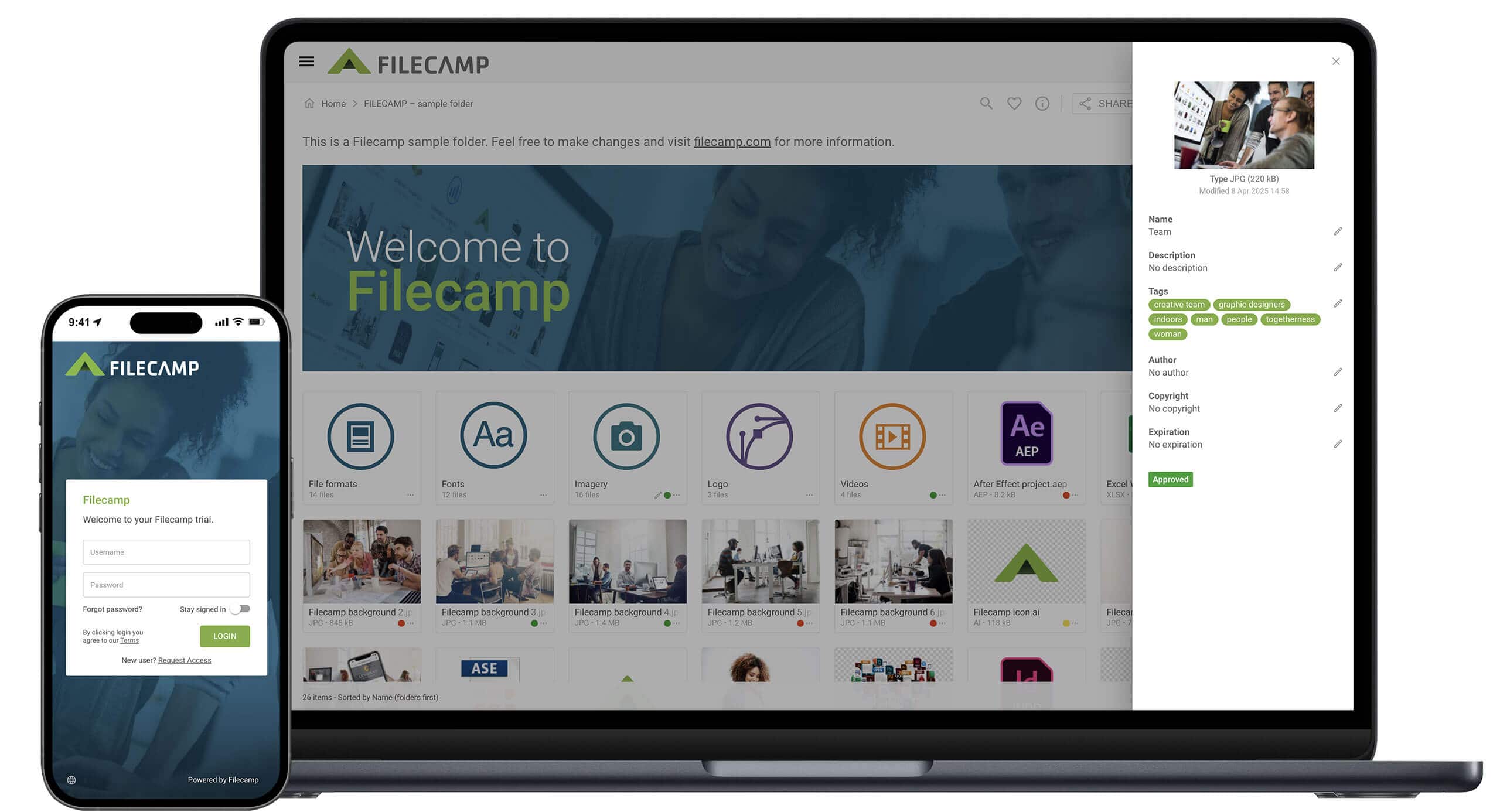DIGITAL Asset Management
How Cloud DAM Powers Brand Consistency
Your brand is more than a logo. It's the consistent ‘feeling’ someone gets whether they're scrolling Instagram at lunch, opening your email newsletter, or browsing your website after work. Keeping that experience the same across dozens of channels, hundreds of assets, and multiple team members gets messy fast.
Cloud-based Digital Asset Management systems give everyone a single spot to grab files. Your logos, photos, videos, and templates all live in one place. Your team knows exactly where to look, and nobody's digging through old emails wondering which version to use.
Your Single Source of Truth
Branding falls apart when your files are scattered everywhere. Design assets live in Dropbox, photos sit in Google Drive, videos are on someone's laptop. That old logo from 2019? Still floating around in email threads somewhere, waiting to make an unwelcome appearance.

This scenario might sound familiar. Someone on your team needs the company logo for a quick social post. They search their computer, find three versions, and pick one that looks right. Later, they discover it's from before the last rebrand, and now thousands of people are seeing it on Instagram. Not to worry, forgiveness is always easier to ask for than permission!
A cloud DAM helps to prevent this situation. Everyone grabs files from the same library, which means they're always using current, approved versions. Most small businesses don't have someone reviewing every piece of content before it goes out. That’s why digital asset management is especially effective for smaller teams. People can find and use the right materials, but it doesn’t require an entire team to manage the process.
Building Your Asset Library Strategically
Once you've got centralized storage sorted, figure out what should actually live in your DAM. To begin with, just think about the essentials that you use often, like logos, brand colors, and fonts. These building blocks appear everywhere your brand shows up, so they need to be easily accessible.
Once you have the basics in place, it’s important to be strategic about how you build your DAM out. Marketing materials are the logical next place to focus. Product photos, custom graphics, email headers, and templates for social media will all be things people need to access sooner or later.

Finally, you can start thinking about specific pieces of content, and this is where digital asset management blends in with the principles of good content marketing. It’s no use spending days creating a new blog post if no one wants to read it. Think about what your customers ask about most often, and those things become obvious areas to target. Then, if you want to get a bit more scientific, a keyword difficulty checker can help you see what people are actually searching for.
Managing Product Assets at Scale
Looking after some logos and content marketing pieces is one thing, but imagine an eCommerce brand with a massive photo collection. Every product needs shots from multiple angles with matching lighting and styling. Your task just got exponentially bigger.

A DAM helps you organize these images so they're actually easy to find. The automatic formatting feature is a game-changer. Upload one high-res photo and your DAM spits out a square version for Instagram, a vertical crop for Stories, and a wide banner for your homepage. Same image, same vibe, different dimensions. Nobody's opening Photoshop twelve times anymore.
This has the biggest impact when you’re trying to manage a huge catalog. Consider a company selling clothing online. They could be managing hundreds or thousands of product images that need to stay cohesive everywhere they sell. Without a DAM doing the formatting work, someone's manually resizing and optimizing each image for every channel. You can imagine how much time you’d save in this aspect alone.
Managing Rebrands and Updates
Of course, your assets won't stay static forever. Rebrands sound exciting until you count how many places your old logo is hiding. Trying to get everyone to use the new versions could be compared to herding cats!

Using DAM for rebranding makes the transition much more manageable. Archive your old assets but mark them as outdated, and then upload your new materials. Make it simple for your team to find what they need, because people will almost always choose the ‘easiest’ option.
Yes, making your DAM work still requires some effort. But if you get into good housekeeping habits from the outset, you’ll find that even something as complex as a rebrand runs surprisingly smoothly.
Coordinating Product Launches
Product launches require just as much, if not more, coordination compared to rebranding. You've got press releases, social posts, email campaigns, partner kits, and sales materials all going live simultaneously. One wrong asset can undermine everything.
Using DAM for product launches gives you central control. Organize everything in folders that are easy to understand. Set release dates to prevent early leaks. Ensure everyone has access to what they need when they need it. Product teams upload final images. Marketing builds campaigns with approved materials. Sales grabs updated one-pagers without hunting through Slack.
Tailoring for Local Markets
You also need to adapt messaging for different markets without losing what makes your brand recognizable. National brands face this constantly—different regions care about different things, but your core identity needs to stay consistent.
Tag your assets by region, and it’ll be easier to adapt your campaigns. A company offering Texas debt relief needs messaging that resonates with Texans specifically, not generic financial advice. Your DAM stores region-tagged versions so the right message hits the right audience.
Take it further with Dynamic Content Optimization. Someone in Dallas visits your site and sees Dallas-relevant imagery. A Miami visitor gets Miami-specific content. Your DAM supplies the pre-tagged variations. The DCO platform handles how and where it’s delivered. Set it up once, and it runs on autopilot.
Aligning Marketing and Sales
Having all your assets organized in a DAM only works if teams can actually collaborate effectively. Marketing spends weeks crafting campaign assets with the latest messaging, then sales creates their own materials from scratch because they can't find what marketing made. Or they find an outdated version saved on their computer and use that instead.

Prospects hear one message from your marketing materials, and then they get a different pitch from sales. It's confusing at best, deal-killing at worst. A shared DAM fixes this disconnect by giving both teams access to one library. Marketing uploads their finished assets. Sales searches by product, industry, or use case and finds exactly what they need. This kind of digital asset management for marketing and sales teams eliminates the back-and-forth and ensures everyone's telling the same story.
Build dedicated collections for sales. Case studies organized by vertical. Product sheets with the latest specs. Demo videos to explain more complex features. When sales reps have instant access to polished materials, they stop improvising with outdated PowerPoints or cobbling together their own versions that drift from the brand message.
Deploying Across Different Channels
You've got your assets organized and your library growing. Now you need to actually use them consistently. Your website should have the same ‘feeling’ as your emails or social media posts. Remember, customers don't know or even care about your internal systems. They just want to know if you’re the right company for their own needs, and having a unified message plays an important role.
Stanislav Khilobochenko, VP of Customer Services at Clario, explains: "You'd be surprised how much the details matter. Customers notice when there's a disconnect between channels, and we put a lot of effort into making sure everything aligns. It absolutely helps to build trust."
This concept is known as an omnichannel customer experience, and while it might sound scary, a digital asset management system can make it relatively painless. It keeps everything aligned so you're not contradicting yourself across platforms or confusing people with different versions of the same message.
Here are some simple ways to make it work. Tag assets for specific audiences. Store versions aimed at different customer personas or industries. Then, pull the right one for each interaction. Tech prospects see case studies from tech companies. Retail prospects get retail-focused examples. It’s the same tool, but now you’re starting to employ ‘next level’ strategies.
Why Consistency Builds Trust
Sloppy branding costs you more than you might realize. When customers see mismatched logos, inconsistent colors, or conflicting messages across your channels, they notice. Maybe not consciously, but it registers somewhere in the back of their mind. That little voice asks: Is this company legitimate? Do they have their act together? Can I trust them with my money?

Think about the brands you know and trust. They look the same everywhere you encounter them. Their emails match the tone and appearance of their website and social posts. That consistency isn't an accident. Someone, or something, is making sure all those pieces fit together properly.
Making It Work for Your Team
Cloud DAMs make consistency achievable without needing the resources of huge organizations. Your team moves faster because hunting for files doesn't eat up half their day. Local campaigns stay on-brand without constant supervision. Product launches happen without chaos. You've built a system where doing it right is easier than doing it wrong.
If you're ready to stop losing hours to file searches and version confusion, Filecamp offers a cloud DAM built for teams who need their assets working harder than their people. Start with a free trial and see just how easy it is to get everyone on the same page.


Roman Shvidun
Share this Post
